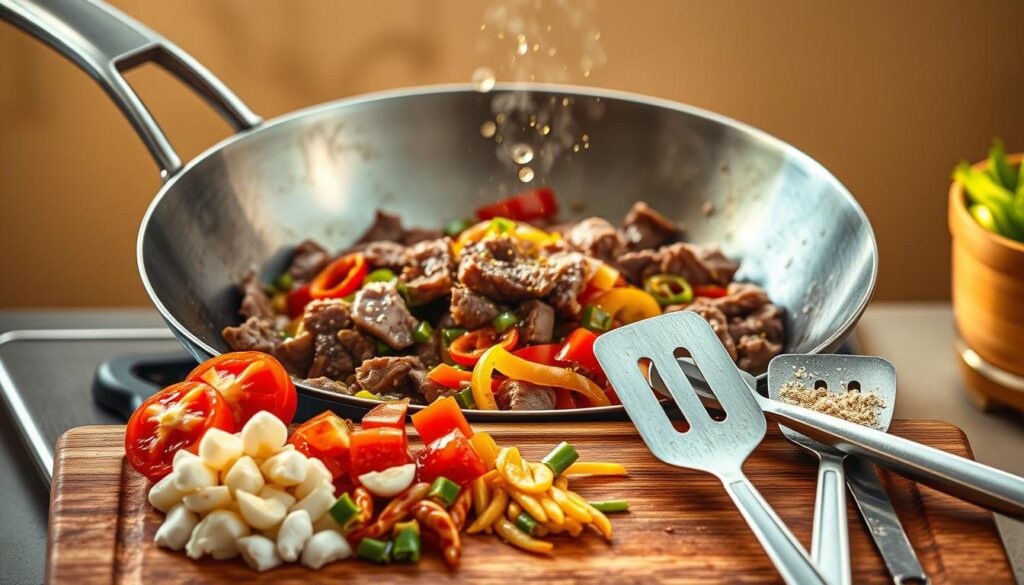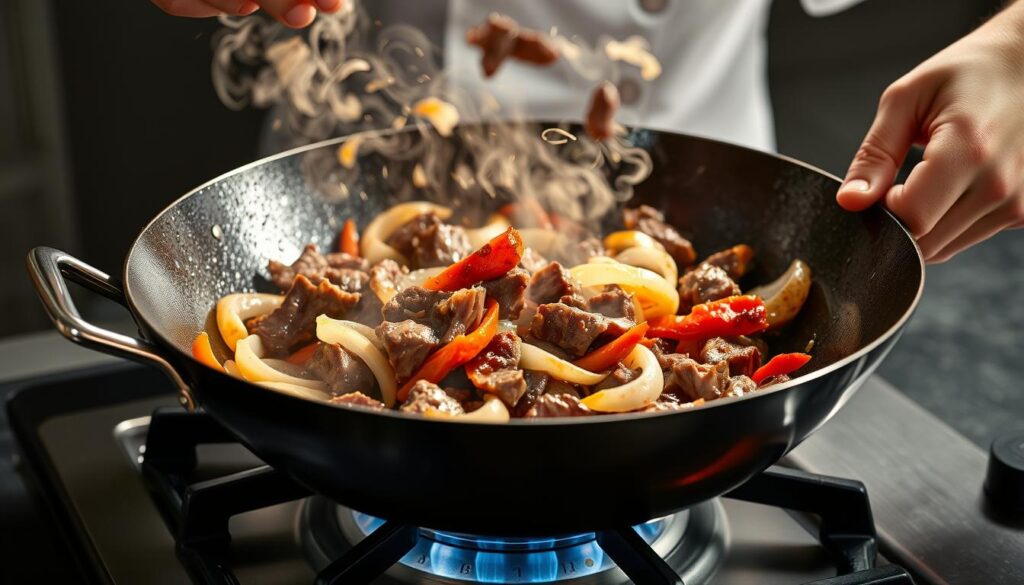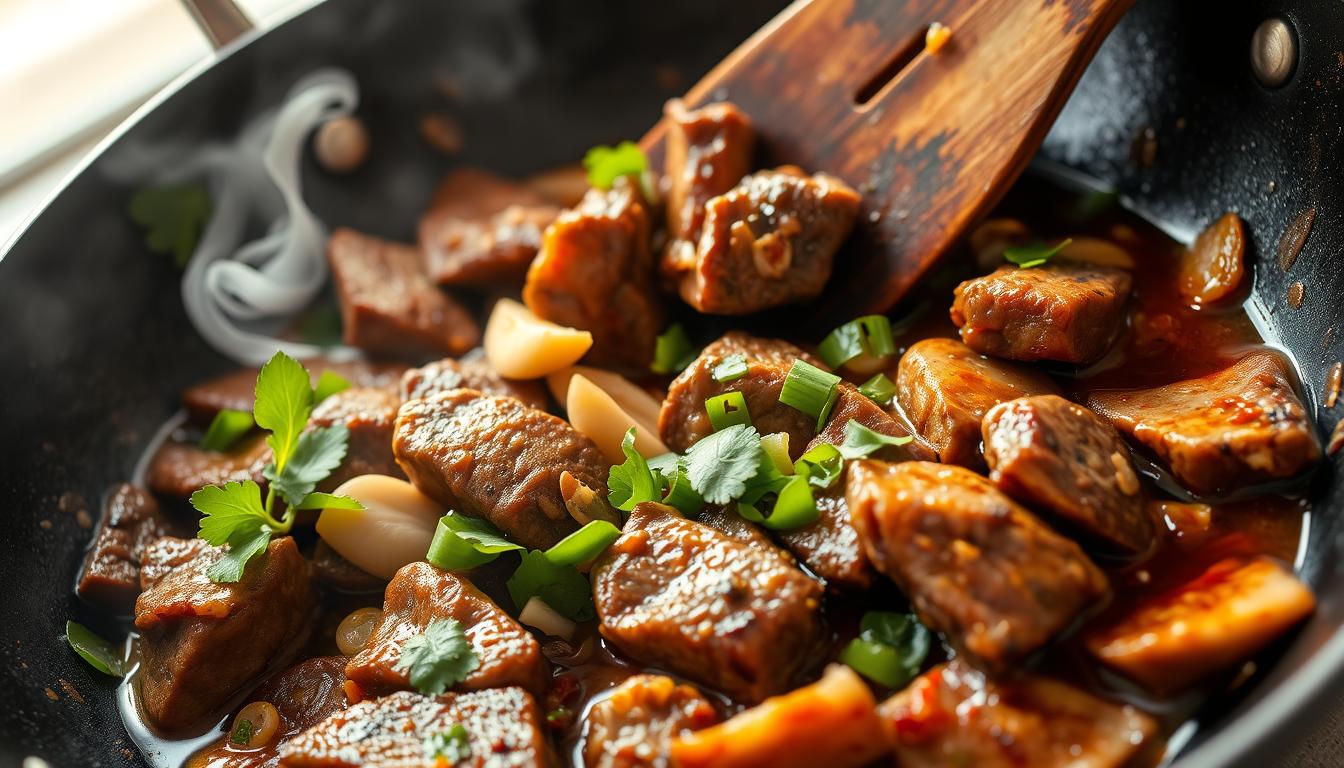Discover the magic of shaking beef, a vibrant recipe for shaking beef that brings the rich flavors of Vietnamese cuisine straight to your kitchen. This classic stir-fry dish, showcased on luyarecipes.com, transforms simple ingredients into a culinary masterpiece that will transport your taste buds to the bustling streets of Vietnam.
The unique name “shaking beef” comes from the cooking technique that involves vigorously shaking the meat in a hot wok, creating a perfect caramelization that locks in incredible flavor. Whether you’re a cooking enthusiast or a novice chef, this recipe offers an authentic taste of Vietnamese cuisine that’s both accessible and delicious.
Key Takeaways
- Learn an authentic Vietnamese stir-fry technique
- Master the art of creating caramelized beef
- Explore traditional Vietnamese flavor profiles
- Prepare restaurant-quality dish at home
- Discover the story behind the unique cooking method
Understanding Vietnamese Shaking Beef Origins
Dive into the fascinating world of Vietnamese cuisine and discover the rich history behind one of its most beloved dishes. Shaking beef, known locally as “Bò Lúc Lắc,” represents a culinary treasure that embodies authentic vietnamese flavors passed down through generations.
Vietnamese cuisine carries deep cultural roots that transform simple ingredients into extraordinary meals. This remarkable dish tells a story of creativity, resourcefulness, and culinary innovation that has captivated food lovers worldwide.
Cultural Significance in Vietnamese Culinary Traditions
Shaking beef emerged as a practical and delicious solution for preparing meat in Vietnamese kitchens. The unique cooking technique – rapidly shaking ingredients in a hot wok – minimizes cooking time while maximizing flavor intensity. Chefs developed this method to create tender, succulent meat using limited resources.
“Cooking is about passion, and shaking beef represents the heart of Vietnamese culinary artistry.” – Traditional Vietnamese Chef
Traditional Preparation Methods
The preparation of shaking beef involves carefully selected cuts of beef, typically tenderloin or sirloin. Marinating the meat in a blend of garlic, soy sauce, and other seasonings ensures deep flavor penetration. The rapid shaking technique helps seal in juices and create a delectable caramelized exterior.
Regional Variations
Different regions of Vietnam offer unique twists on this classic dish. Northern provinces might use more robust marinades, while southern regions incorporate sweeter flavor profiles. Each variation showcases the diversity of authentic vietnamese flavors within vietnamese cuisine.
Essential Ingredients for Perfect Shaking Beef
Creating an authentic savory beef recipe starts with selecting the right ingredients. For your shaking beef, you’ll want to choose high-quality beef cuts like sirloin or tenderloin. These premium cuts ensure tender, flavorful meat that captures the essence of Vietnamese cuisine.
The garlic and soy sauce marinade is crucial to developing deep, rich flavors. Fresh garlic cloves, minced finely, provide an intense aromatic base. Combine this with premium soy sauce, which adds depth and umami to your dish. Dark soy sauce works best for creating that signature caramelized exterior.
“The secret to great shaking beef lies in the quality of your ingredients and the precision of your marinade.” – Vietnamese Culinary Expert
Your ingredient lineup should include additional flavor enhancers like fish sauce, which brings a complex saltiness, and a touch of sugar to balance the savory notes. Fresh herbs such as cilantro and green onions will add brightness and freshness to the final presentation.
Don’t forget supporting ingredients like shallots, which provide a delicate sweetness, and black pepper for a subtle kick. Fresh lime juice at the end will help cut through the richness of the beef, creating a perfectly balanced dish that sings with authentic Vietnamese flavors.
Recipe for Shaking Beef: Step-by-Step Guide
Creating an authentic beef stir-fry at home can transform your cooking experience. This recipe for shaking beef brings the vibrant flavors of Vietnamese cuisine directly to your kitchen. With careful preparation and the right techniques, you’ll master this delicious dish in no time.

Crafting the perfect beef stir-fry requires attention to detail and understanding of key culinary principles. Each step plays a crucial role in developing the rich, complex flavors that make this dish so remarkable.
Selecting the Right Cut
Choose high-quality beef sirloin or tenderloin for your shaking beef recipe. These cuts provide tender meat that absorbs marinade beautifully. Look for meat with minimal fat marbling and a bright red color, ensuring maximum flavor and texture in your beef stir-fry.
Marinade Magic
The secret to an outstanding shaking beef lies in its marinade. Combine soy sauce, garlic, sugar, and black pepper to create a robust flavor profile. Let the beef sit in this mixture for at least 30 minutes, allowing the meat to absorb the delicious seasonings completely.
Cooking Technique Essentials
When preparing your beef stir-fry, use a scorching hot wok or heavy skillet. The high heat creates a perfect sear, locking in juices and developing a delightful caramelized exterior. Shake the pan frequently to ensure even cooking and that signature movement that gives the dish its name.
“The key to great shaking beef is high heat and constant movement” – Chef Martin Yan
Mastering the Lemongrass Marinade
Creating an authentic vietnamese flavors lemongrass marinade transforms ordinary beef into a culinary masterpiece. The secret lies in understanding how to extract maximum flavor from fresh lemongrass stalks. You’ll want to select firm, pale green stalks with a vibrant citrusy aroma.
Your lemongrass marinade begins with careful preparation. Start by trimming the tough outer layers and finely mincing the tender inner core. This technique releases the essential oils that provide that distinctive tangy essence characteristic of Vietnamese cuisine. Combine the minced lemongrass with garlic, fish sauce, and a touch of sugar to balance the intense aromatics.
“The key to an exceptional lemongrass marinade is patience and precision in ingredient selection.” – Vietnamese Culinary Expert
Marinating your beef requires strategic timing. For optimal flavor penetration, allow the meat to rest in the lemongrass marinade for 30 minutes to 2 hours. Longer marination can break down protein fibers, resulting in incredibly tender meat that captures authentic vietnamese flavors perfectly.
Pro tip: Always use fresh ingredients and avoid shortcuts. The quality of your lemongrass directly impacts the depth and complexity of your marinade. Select stalks that are fragrant and bright green, indicating peak freshness and maximum flavor potential.
Proper Meat Tenderizing Techniques
Creating a delicious quick beef dish requires mastering meat tenderizing techniques that transform tough cuts into mouthwatering meals. Understanding how to break down muscle fibers can elevate your cooking skills and ensure restaurant-quality results at home.
Professional chefs know that meat preparation is an art form. Different meat tenderizing techniques can dramatically improve the texture and flavor of your beef, making even budget-friendly cuts incredibly delectable.
Chemical Tenderizing Methods
Chemical tenderizers work by breaking down protein structures. Ingredients like pineapple juice, papaya, and baking soda can soften meat fibers quickly. Acidic marinades help denature proteins, creating a more tender texture perfect for your quick beef dish.
“The secret to tender meat is understanding how enzymes interact with protein structures.” – Chef Marcus Rodriguez
Physical Tenderizing Approaches
Mechanical methods such as scoring, pounding, and using a meat mallet can physically break down tough muscle fibers. These techniques create microscopic tears that help marinades penetrate deeper and make meat more tender and easier to chew.
Marination Timing Guide
Timing is crucial when tenderizing meat. Delicate cuts require shorter marination periods, while tougher meats benefit from longer soaking. Typically, 30 minutes to 2 hours is ideal for most beef dishes, preventing the meat from becoming mushy or losing its natural texture.
The Art of Stir-Frying Shaking Beef

Mastering the beef stir-fry requires precision and skill. The secret to creating an authentic sizzling beef dish lies in understanding the delicate balance of heat and timing. Your wok or heavy skillet becomes the key instrument in transforming simple ingredients into a culinary masterpiece.
“Stir-frying is not just cooking, it’s an art form that demands your full attention and respect for ingredients.” – Chef Martin Yan
Start by preparing your cooking surface. A blazing hot pan is crucial for achieving that perfect caramelized exterior on your beef. Ensure your skillet is preheated to a high temperature before adding the meat. The characteristic sizzling beef sound is your indicator of proper heat distribution.
The traditional “shaking” technique gives this dish its unique name. Quick, rapid movements prevent the beef from overcooking while creating an even sear. Move your beef quickly around the pan, allowing each piece to develop a rich, golden-brown crust. This technique ensures tender meat with maximum flavor concentration.
Timing is everything in a successful beef stir-fry. Most cuts require no more than 2-3 minutes of total cooking time. Watch for visual cues: meat should appear slightly charred on the edges but remain juicy in the center. Practice and patience will transform your stir-frying skills from amateur to professional.
Pairing Suggestions and Side Dishes
When serving your savory beef recipe, the right accompaniments can elevate your Vietnamese cuisine experience. Selecting the perfect side dishes transforms a simple meal into a culinary adventure that delights your taste buds.
Traditional Vietnamese Accompaniments
Classic Vietnamese cuisine traditionally pairs shaking beef with steamed jasmine rice. The fluffy white rice absorbs the rich, savory flavors of the beef, creating a harmonious balance. A refreshing watercress salad adds a crisp texture and light, peppery note that cuts through the beef’s intensity.
“The magic of Vietnamese cooking lies in balancing flavors and textures” – Chef Mai Nguyen
Modern Fusion Options
For those seeking innovative twists, consider pairing your savory beef recipe with quinoa, cauliflower rice, or a zesty Asian slaw. These modern alternatives provide unique flavor profiles while maintaining the spirit of traditional Vietnamese cuisine. Experiment with pickled vegetables or a tangy lime-cilantro dressing to add unexpected depth to your meal.
Remember, the key is creating a balanced plate that complements the rich, tender beef and allows each ingredient to shine.
Troubleshooting Common Cooking Issues
Creating the perfect quick beef dish can sometimes be tricky. When preparing your recipe for shaking beef, you might encounter a few common challenges that can make or break your meal. Understanding how to overcome these cooking obstacles will help you achieve restaurant-quality results every time.
Meat tenderness is crucial in shaking beef. If your beef turns out tough, it’s often due to overcooking or using the wrong cut of meat. Choose tender cuts like sirloin or tenderloin, and cook the beef quickly over high heat. Marinate the meat for at least 30 minutes to help break down muscle fibers and enhance flavor.
“The key to perfect shaking beef is high heat and quick cooking!” – Vietnamese Culinary Expert
Caramelization can be another tricky aspect of this quick beef dish. If your meat isn’t developing that beautiful golden-brown exterior, ensure your pan is extremely hot before adding the beef. Don’t overcrowd the pan, which can cause steaming instead of searing. Use a cast-iron skillet or wok for the best results.
Salt balance is critical in your recipe for shaking beef. If your marinade tastes too salty, try balancing it with a bit of sugar or lime juice. Always taste and adjust seasonings before cooking. For those who prefer less sodium, you can reduce the salt and use more herbs and spices to build depth of flavor.
Lastly, practice makes perfect. Each time you prepare shaking beef, you’ll become more confident in managing heat, timing, and seasoning. Don’t get discouraged by initial setbacks – they’re just part of becoming a skilled home cook.
Storage and Reheating Guidelines
Preserving the delectable flavor and texture of your beef stir-fry requires careful storage and reheating techniques. Knowing how to properly handle your leftover sizzling beef ensures you can enjoy a restaurant-quality meal even days after cooking.
Smart Storage Strategies
Your beef stir-fry needs proper containment to maintain its quality. Use airtight containers or heavy-duty resealable bags to store your sizzling beef. Place the beef stir-fry in the refrigerator within two hours of cooking to prevent bacterial growth. Refrigerated beef stir-fry typically remains fresh for 3-4 days.
Freezing Your Beef Dish
Freezing offers an excellent option for longer-term storage. Wrap your sizzling beef tightly in freezer-safe containers or vacuum-sealed bags. Most beef stir-fry can be frozen for up to two months without significant flavor loss. Label containers with the date to track freshness.
Reheating Techniques
Bringing back the original texture of your beef stir-fry requires gentle reheating. A wok or large skillet works best for restoring that signature sizzle. Use medium heat and add a small amount of oil to prevent sticking. Stir frequently to distribute heat evenly and avoid overcooking the tender beef.
“The key to great leftovers is treating them with the same care as the original meal.” – Professional Chef Recommendation
Microwave Alternative
When time is short, the microwave can work. Use a microwave-safe dish and cover with a damp paper towel to retain moisture. Heat in 30-second intervals, stirring between each to ensure even warming of your beef stir-fry.
Health Benefits and Nutritional Information
Your favorite savory beef recipe from Vietnamese cuisine offers more than just incredible flavor. Shaking beef is a nutritional powerhouse packed with essential proteins and vital nutrients that support a healthy diet. A typical serving provides approximately 25-30 grams of high-quality protein, which helps muscle development and supports overall body function.
The lean beef used in this traditional vietnamese cuisine dish is rich in critical nutrients like iron, zinc, and vitamin B12. These components play crucial roles in maintaining energy levels, supporting immune function, and promoting red blood cell production. By selecting quality beef cuts, you maximize the nutritional potential of this delectable stir-fry.
“Food is our body’s fuel, and shaking beef represents a perfect balance of taste and nutrition” – Vietnamese Culinary Expert
Calorie-conscious individuals will appreciate that a standard portion of shaking beef ranges between 250-300 calories. The dish’s balanced composition of protein, vegetables, and minimal oils makes it an excellent choice for those monitoring their dietary intake. You can easily customize the recipe to align with specific dietary requirements without sacrificing its authentic Vietnamese flavor profile.
Remember that the nutritional value extends beyond mere numbers. The fresh herbs and vegetables accompanying the beef contribute additional vitamins, minerals, and antioxidants, transforming this savory beef recipe into a comprehensive, health-supporting meal.
Conclusion
Your adventure in creating an authentic recipe for shaking beef is now complete. By mastering this traditional Vietnamese dish, you’ve unlocked a world of rich flavors and culinary technique that goes far beyond simple cooking. The journey from selecting premium beef to perfecting the stir-frying method represents a true celebration of authentic Vietnamese flavors.
Luyarecipes.com invites you to embrace the art of Vietnamese cooking with confidence. Each time you prepare shaking beef, you’ll refine your skills and develop a deeper appreciation for the cultural nuances embedded in this beloved dish. Remember that cooking is an ongoing learning experience where precision meets creativity.
The recipe for shaking beef is more than just a meal—it’s a connection to Vietnamese culinary traditions. Whether you’re cooking for family or exploring new cuisines, this dish offers a delicious gateway into understanding the depth and complexity of Southeast Asian gastronomy. Keep experimenting, stay curious, and enjoy every moment in your kitchen.
Your culinary exploration doesn’t end here. Continue discovering new recipes, techniques, and flavor combinations that challenge and inspire your cooking skills. Luyarecipes.com remains your trusted companion in this delicious journey of global cuisine.
FAQ
What is shaking beef, and why is it called that?
Shaking beef (Bò Lúc Lắc) is a popular Vietnamese stir-fry dish where beef cubes are quickly tossed or “shaken” in a hot wok or pan, creating a signature cooking technique that gives the dish its unique name. This method helps to caramelize the meat and create a delicious sear on the outside while keeping the inside tender and juicy.
What cut of beef works best for shaking beef?
The best cuts for shaking beef are tender, high-quality cuts like filet mignon, sirloin, or tenderloin. These cuts are ideal because they remain tender during the quick, high-heat cooking process and absorb the marinade beautifully. Look for well-marbled meat that will stay juicy and flavorful when stir-fried.
How long should I marinate the beef?
For optimal flavor, marinate your beef for 15-30 minutes before cooking. Avoid marinating for too long, as the acids in the marinade can begin to break down the meat’s texture. The key is to let the beef absorb the flavors of garlic, soy sauce, and other aromatics without compromising its tender texture.
Can I make shaking beef if I don’t have a wok?
Absolutely! While a wok is traditional, you can successfully make shaking beef in a large skillet or cast-iron pan. The most important factors are using high heat and having enough surface area to allow the beef to sear properly without overcrowding the pan.
What are the essential ingredients for the marinade?
The classic shaking beef marinade typically includes soy sauce, garlic, sugar, black pepper, and fish sauce. Lemongrass is often added for an authentic Vietnamese flavor. These ingredients create a perfect balance of sweet, savory, and umami flavors that make the dish so distinctive.
What side dishes pair well with shaking beef?
Traditional accompaniments include steamed white rice, a simple watercress salad, or pickled vegetables. The fresh, crisp sides help balance the rich, savory flavors of the beef. For a complete meal, you might also serve it with a light dipping sauce made from lime juice, salt, and pepper.
How do I prevent the beef from becoming tough?
To keep the beef tender, follow these tips: use high-quality, tender cuts, don’t overcook the meat, cook on high heat for a short time, and avoid moving the beef too much while it’s searing. Marinating briefly and cooking quickly are key to maintaining a juicy, tender texture.
Can I make this recipe gluten-free?
Yes, you can easily make a gluten-free version by using tamari or gluten-free soy sauce instead of traditional soy sauce. Ensure all other ingredients are also gluten-free, and you’ll have a delicious shaking beef that meets dietary restrictions.









